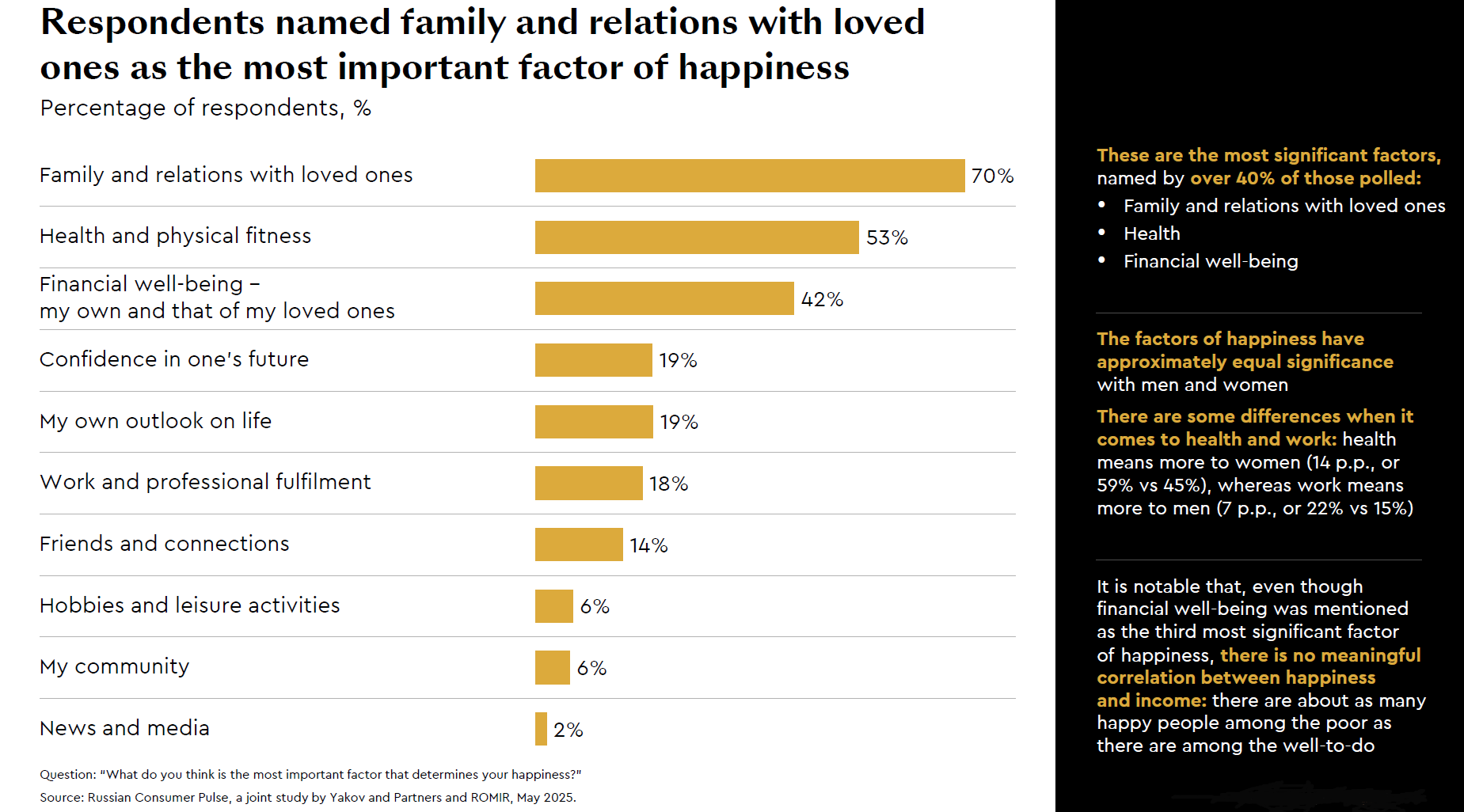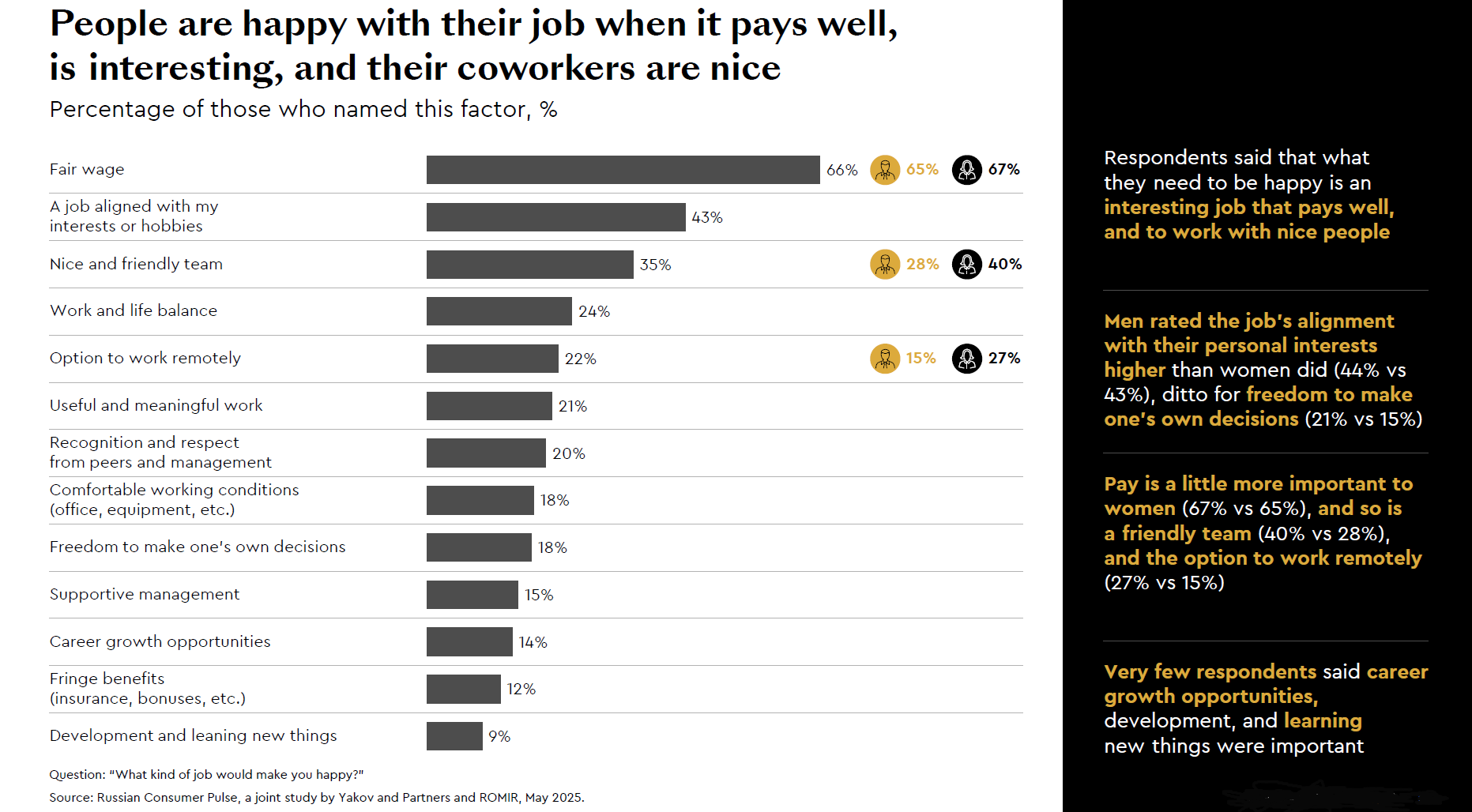About 65% of Russians are satisfied with their lives, while 63% think they are happy. These are the findings of a new joint study by Yakov and Partners and ROMIR, “The new Russian society: what happiness is made of.”
The survey was undertaken in May 2025 using the ROMIR Longitudinal System, a social measurement tool that helps analyze public sentiment as it evolves, taking into account all the specifics and segmentation by socio-demographic characteristics, lifestyle, values, and other criteria.
Contrary to the widespread belief, income level, gender, and education do very little to make a person happy. For example, very nearly the same percentage of happy people is found among those earning under RUB 50K/month and those earning more than RUB 100K.
For happiness, most respondents look to family and relations with loved ones (some 70% of those polled), health (53%) or financial well-being (42%). Marital status also matters: people who are married turned out to be 9 p.p. happier than those living in a common-law relationship.
Having children contributes greatly to the subjective well-being of their parents. Sixty-nine percent of parents with a single child said they were happy, but the percentage rises to 71% for parents with two children, reaching 80% among families with three children. There’s a marked surge in women’s happiness levels when their first child is born: the difference is as much as 14 p.p.
Elena Kuznetsova, Director of Research Institute at Yakov and Partners.
Our study has found that happiness levels vary markedly between people depending on their occupation. Seventy-six percent of entrepreneurs describe themselves as happy, and 41.8% of those rate their well-being as five out of five. Hired employees are a close runner-up in happiness level: 63.7% are satisfied with their life. It is interesting to note that people who are unemployed by choice are less happy than those who have a job. The smallest percentage of happy people is found among those looking for work. Men in this cohort feel less happy than women, with a difference of 9 p.p.
Our survey shows that employment often contributes to the overall sense of satisfaction with one’s life on top of serving as a means of making a living. Some 45% of respondents said they enjoy their work. The age group of 35 to 44 showed the highest level of engagement: half of the people polled in this cohort said they love their job. Only 31% answered likewise in the younger age group of 18 to 24. The percentage of people finding it difficult to define how they feel about their job increases sharply after the age of 55. According to experts, this may be explained either by the force of habit or by the loss of the previous significance of work in general, as well as by the fact that Russians may no longer be employed in this group.
To be happy with their job, most respondents said they would want it to pay well (stated by 67% of women and 65% of men), be aligned with their personal interests (44% of men and 43% of women), and provide a positive team environment (40% of women and 28% of men).
In fact, respondents who think their job is useful, meaningful, and aligned with their interests show a happiness level 7 to 11 p.p. above those who find no such characteristics in their current job. This suggests that work contributes to our sense of well-being on a much deeper level than is usually believed. A meaningful, rewarding job is not just an occupation; it is a source of inner stability and satisfaction that spreads into every aspect of life
Pavel Egorov, Research Lead at Yakov and Partners’ Research Institute
It is curious how the feeling of happiness changes with age. Subjective well-being forms a U-curve over the course of one’s life. Two most significant slumps in happiness occur at around the ages of 30 and 50–54. This is in keeping with the international studies performed in the US, Germany, Japan, and across the EU. In Russia, however, there is also an interim peak at the age of 35 to 40. This age period often coincides with achieving professional stability, starting a family, and being relatively free from external pressures. The level of life satisfaction rises again after the age of 55. Experts believe this may be due to diminished work pressure, decreased parental burden, and much more free time to spend doing the things you enjoy doing or your hobbies.
A distinctive feature of the Russian context is the presence of a pronounced intermediate peak in life satisfaction, which occurs around the age of 35–40. At this stage, Russians typically achieve professional stability, successfully start families, and have not yet encountered the challenges of the pre-retirement period. Notably, after the age of 55, life satisfaction levels begin to rise again. This positive trend may be linked to having more time for personal interests, discovering new hobbies and passions, and the opportunity to devote more attention to family and grandchildren, thereby strengthening intergenerational ties and fostering strong family values
Inna Karaeva, Executive Director at ROMIR





